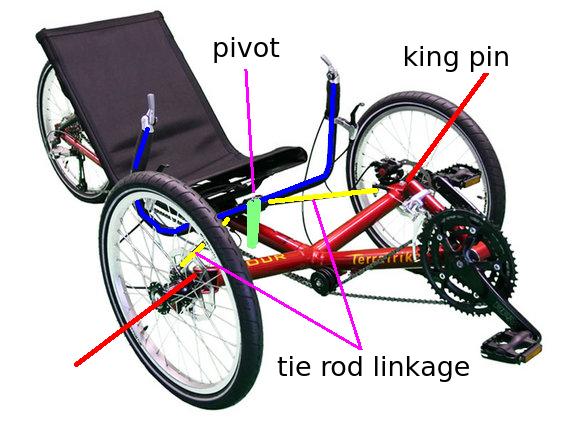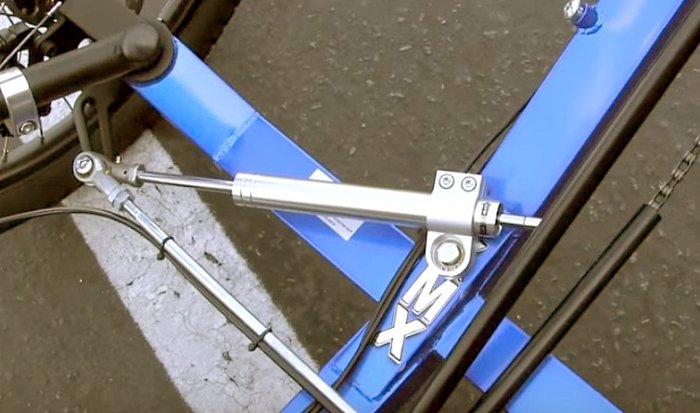Those who have been following my writings from the git go probably know that I got my start in this writing articles about tadpole trikes on Steve Greene’s Trike Asylum blog. One of my earliest articles (To Motorize Or Not To Motorize, That Is The Question which was posted on April 5, 2013) was on the subject of motorizing a tadpole trike and I made it pretty clear that I was against it. I made an exception for those who truly needed it Never the less I ruffled some feathers and caught some flak for writing the article. I have to admit that when I wrote it I didn’t know much about the subject of motorizing a trike. I don’t recall whether or not I was even aware of “pedal assist”. Anyway, since that time I have gotten myself a bit more educated about pedal assist. I also finally reached the point I felt I would benefit from having electric motor pedal assist. I have had one on my trike now for awhile so I have experience with using it and feel I am qualified to write about it. I am loving it. Anyway, I am reposting the early article I wrote so you can read it here in this posting. You will find it at the bottom of this article I am now writing. As you read thru it you should be able to pick up that I was thinking that this subject matter is about propulsion by a motor and not pedal assist.
Recently a fellow triker brought up the matter of a tadpole trike being a Human Powered Vehicle (HPV) … that is to say, they are suppose to be. Hey, that is exactly the position I used to hold so I know where he is coming from. We are all familiar with the terms “Pros & Cons” … stating those things in support or favor of and those things which are not if support or favor of. After having a motorized pedal assist trike and riding it quite a lot already I though it would be good to try to write an unbiased opinion and report on the pros and cons of having a pedal assist motor enhancement. Of course, now I speak only of “PEDAL ASSIST”. I like the description … “it’s like having a built in tail wind”. I am still against a motor propelling a trike where the rider is not required to pedal.
I will state the things that come to mind as pros as well as those things which come to mind as cons. I will say upfront that the list will be considerably lop sided as I have been giving thought to this matter and have to say that there is very little I can come up with to put on the cons list while there is a whole lot that comes to mind to place on the pros list. This certainly is not an exhaustive list. As I think of more I will add them to the lists.
THE PROS
1) It makes pedaling easier not requiring nearly as much pressure to be exerted on the pedals. This greatly helps in hill climbing and those with knee joint problems, pain and weakness.
2) The rider can go considerably faster even though they are exerting the same amount of pressure on the pedals and using the same amount of energy as they did previously. For instance, climbing a hill that used to slow me down to 2 to 4 mph I can now ride up at 14-16 mph if I want to.
3) If the rider tires out during a ride the motor assist helps them to get back to wherever they started from or need to get to.
4) If riding has become a chore rather than the fun it once was then pedal assist can make it fun again.
5) It enables a rider to ride at a faster pace so that being able to ride with faster riders is now possible. You still won’t be able to keep up with a lot of the roadies however as they really go. Funny thing is they are allowed on bike trails and some bike trails ban pedal assist bikes and trikes. It is not right.
6) It is a real blessing to have when you need to zip across a busy street when a break in traffic finally comes along. It can propel you across fast and out of any danger.
7) When you need to make good time to get some place faster than you normally could again the motor is such a blessing.
8) Having the ability to accelerate quickly and go fast can be a big help in getting away from a dog or person you might be concerned about as far as your personal safety. Of course, most dogs can run faster than 20 mph.
9) Because you are still pedaling, but pedaling easier you actually get more exercise. You can pedal at a faster cadence which is a very good thing as many of us pedal way too slowly anyway. And because it is easier to pedal you can ride longer.
10) Someone who has had problems with hernias and are concerned about overexerting them self and causing serious problems can greatly benefit from having pedal assist.
11) Having electric motor pedal assist does not mean that you have to use it. You can ride with it turned off just like it wasn’t there. And quite honestly most of the time I can’t tell the difference between riding my trike as it came from the factory and riding it now with the motor and battery installed but not turned on.
12) If you have long downhill grades you can set the controls to generate rather than use power and in doing this you recharge the battery. You can also just ride along recharging the battery if you are strong enough to pedal with the resistance involved. Or if you are up to the task even on level ground you can pedal along recharging the battery if you are physically up to it. Please note that the charging rate in this mode is very little so it would take a lot of time and travel to put much of a charge back into the battery.
13) You can play with the minds of the road bike riders by being able to ride their speed and maybe even pass them. Some of them however ride much faster than a motorized pedal assist can go (legally).
14) When riding off road the pedal assist is great to have. It makes such adventure so much easier and enjoyable and even safer as one doesn’t always have the strength to pedal in/over/thru some places.
15) It reduces the stress being placed on the drive system (pedals, crankset, chain & sprockets) as the motor is helping to turn the rear wheel.
16) If you are riding with others and you have to stop or slow down and they keep going having the pedal assist motor makes it much easier to catch back up with them.
17) It is great when riding into a headwind. Other than feeling the wind you can truly say “what wind?”.
18) Going with a hub motor does not effect your existing gearing.
THE CONS
1) The motor and battery add weight to the trike. It has added over 20 pounds to my trike and all on the back. That being said, much to my surprise and delight the only time I can tell there is additional weight is when I lift it. When I ride I can’t tell it at all.
2) Being able to go faster is fun, but it also adds a measure of danger and concern that didn’t exist riding slower. You may tend to go into curves faster than you should. If you are not used to handling a trike at higher speeds you could crash.
3) It is expensive to add a motor to a trike and the battery only lasts so long before it needs to be replaced at considerable cost. My conversion kit costs about $2500 and the replacement battery costs about $900 to over $1200 depending upon which battery one has. There is always the chance that the manufacturer will either go out of business or simply not offer a replacement battery later on if they opt to make some changes in their product offerings.
4) Some trails don’t allow the use of any motors on them. I personally don’t think that this should apply to pedal assist systems and I would hope that trails which say no to them will reconsider and change their position on this.
5) Motorizing a tadpole trike adds to the value making it more of a target for a thief.
6) Adding a crank drive motor eliminates one or two of your chainrings upfront greatly effecting your available gearing.
7) Motorizing a trike makes it so much fun to ride that your spouse or boyfriend/girlfriend will want to ride it and cut you out of the picture. 😉
********************
A FREE GIFT awaits you!
**********
I am getting into something here which I will state upfront I am very opinionated about. I”M ‘AGIN’ IT! To my way of thinking motorizing any type of human powered vehicle is defeating the whole concept of the thing … exercise. I mean, come on … if you want a motorized open air vehicle buy a motorcycle for crying out loud. I rode them for over 50 years of my life until I finally decided I would give it up for strictly pedaling around. I was also riding a bicycle all those years so I still got some exercise … just not nearly as much as I do now.
I am sure that there are some folks who are not able to pedal to get around … perhaps can’t use their arms and hands to propel a vehicle either and so they may NEED something in the way of a motorized trike. But there are a whole lot of folks out there who are perfectly capable of pedaling who really don’t NEED to go this route.
That being said, I know it has become pretty popular. The man I sold my homemade tadpole trike to told me he planned on motorizing it. There is lots of information out there on the subject. And I am sure riding a motorized tadpole trike is a lot of fun even though it could lead to an added element of danger. And there may be some folks who just need help pedaling up hills as just maybe their bodies can’t deliver what it takes.
Obviously there are two main ways to go … electric motor or gas engine. Those who oppose gas engines because they “pollute” would no doubt only consider the electric motor route. But I AM STILL AGIN IT!
Here are some pictures of various setups:
KMX trike motorized

gas engine motorized trike

solar charging motorized trike

ecospeed motor on boom

And I say to ya’ll …
KEEP ON PEDALIN’
(We all need the exercise!)
By the way, one needs to be aware that there are trails where it is against the rules to ride a motorized bike or trike. Our local trails here in the Fort Wayne, Indiana area do not allow them. Only motorized wheelchairs are permitted. When it comes to “pedal assist” it is not fair to ban them. They are as much as a human powered vehicle as the roadies out there zooming by at 25 plus mph while my top speed is only 20 mph with pedal assist. HERE is a good article on the subject.
A FREE GIFT awaits you!




























